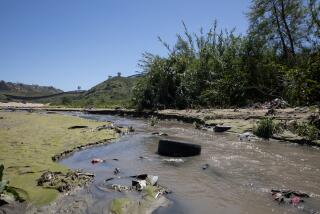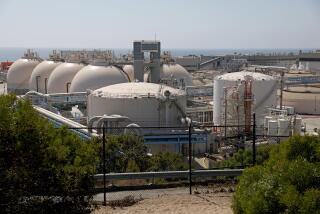Citizen Task Force to Help Plan Sewer Plant
Preparing for the city’s most massive public works project ever, the San Diego City Council on Monday appointed a citizens’ task force and created a new division in the Water Utilities Department to begin planning for a federally mandated $1-billion secondary sewage treatment plant.
These administrative steps, passed unanimously and without debate, follow the council’s decision in February to abandon its quest to sidestep federal regulations requiring the expensive upgrade of municipal sewage treatment plants.
San Diego officials for years had petitioned the U.S. Environmental Protection Agency for a waiver from the regulations, which require secondary treatment to remove 90% of the suspended solids from sewage before it is flushed into the ocean through an underwater pipe.
The city had argued that the advanced primary treatment at its Point Loma plant was good enough because it removes 75% of the suspended solids from sewage.
But EPA officials ultimately disagreed and recently notified the city that a waiver will not be granted. Now, the city must press forward with the upgrade.
22-Member Task Force
To help with the job, council members appointed a 22-member task force consisting of representatives from business, the development industry, engineering and academia. Chairing the group will be E. Miles Harvey, an attorney for Luce Forward, Hamilton & Scripps.
Others on the panel include Mike Madigan, a former aide to ex-Mayor Pete Wilson and now a vice president of Pardee Construction; D. Craig Barilotti, a senior marine biologist with Kelco, a local company that harvests kelp beds; Alan Ziegaus, an executive with the public-relations firm of Stoorza, Ziegaus & Metzger Inc.; Kimball H. Moore of the Sierra Club, and Dennis L. Russell, president of the Building Industry Assn.
The council also established a separate division of five city employees in the Water Utilities Department to begin planning for the treatment plant. Milon Mills, the department’s assistant director, said the new division will “provide the interface between the task force and the consultants that will be hired in the future” to plan the treatment plant.
Mills said the department will soon ask the council to approve a contract for about $400,000 with NBS/Lowry Engineers & Planners to review past sewage treatment plans and help set up a public review process to examine what should be done.
Mills said the department expects the process to take more than three years and will include public hearings and task force meetings to decide how big the secondary treatment plant should be, whether to build one large plant or several small ones, and how to incorporate water reclamation into the project.
In all, he said, it may cost the city nearly $10 million in consultants’ fees alone to make those decisions.
From there, city officials have estimated that it will take another seven years before the plant is designed and constructed.
Mills said a plant that could handle San Diego’s projected sewage needs through the year 2004 would cost $1 billion. A larger plant, equipped to handle the sewage demand through 2040, would cost $1.5 billion, he said.
So far, San Diegans have yet to feel the $1-billion pinch since the council’s decision to go to secondary treatment. But proposed rate increases in the monthly sewer bill are imminent.
The water department is asking for a 63% increase--from $8 to $12.80 a month for the average residential customer--to raise $60 million for improvement and replacement of existing pipes and pump stations. About $10 million of that figure, however, will go to pay the consultants to plan for secondary treatment.
The other engineering and construction costs are not included in the proposed rate increase, which will go before the City Council shortly.
When the bill finally comes due for building the secondary treatment plant, water officials estimate that the average residential customer will be paying $16 to $24 more a month, yielding a total bill of $28.80 to $36.80 a month.
More to Read
Sign up for Essential California
The most important California stories and recommendations in your inbox every morning.
You may occasionally receive promotional content from the Los Angeles Times.










